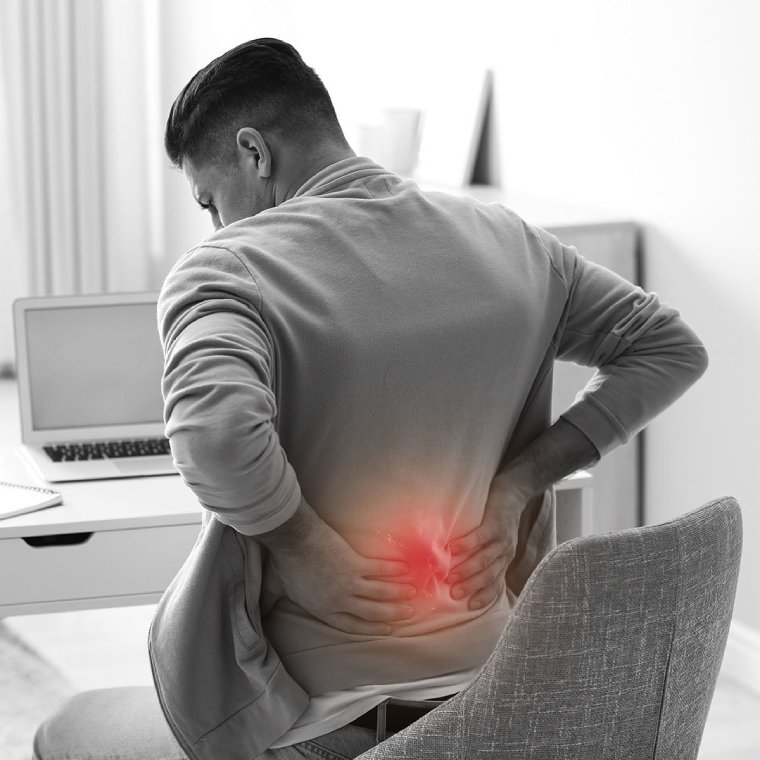Understanding the Impact of Prolonged Sitting on Back Health
Sitting for long periods can take a toll on your back. It puts pressure on your spine and can lead to discomfort or pain. Understanding how sitting affects your back health is the first step to finding relief.
Modern lifestyles often involve sitting at desks, in cars, and on couches for extended periods. This sedentary behavior is a significant factor contributing to back pain. Our bodies are designed for movement, not prolonged sitting.
Common Causes of Back Pain from Sitting
- Poor Posture: Slouching or leaning forward can strain your spine and back muscles, leading to pain.
- Inadequate Support: Sitting in a chair that lacks proper lumbar support can cause your lower back to curve unnaturally, resulting in discomfort.
- Prolonged Sitting: Staying seated for extended periods without taking breaks can lead to stiffness and muscle tension in your back.
- Weak Core Muscles: A weak core can make it difficult to maintain proper posture, putting additional strain on your back.
- Improper Ergonomics: Using a workstation that is not ergonomically designed can force you into awkward positions, contributing to back pain.
- Crossing Legs: Sitting with crossed legs can cause hip misalignment and lead to lower back pain.
- Repetitive Movements: Repeatedly performing the same movements while seated, such as typing, can strain your back muscles.
- Lack of Movement: Not moving around enough throughout the day can cause muscles to become tight and less flexible, increasing the risk of pain.
- Old or Worn-Out Furniture: Using chairs or desks that are not in good condition can fail to provide adequate support, leading to discomfort.
- Stress and Tension: Emotional stress can cause you to tense your back muscles, leading to pain, especially when sitting for long periods.
The Benefits of Massage Therapy for Back Pain
- Relaxes Tight Muscles: Massage therapy helps to loosen and relax muscles that are tight or knotted, reducing discomfort and pain.
- Improves Circulation: By increasing blood flow, massage therapy helps deliver more oxygen and nutrients to the affected areas, promoting healing.
- Reduces Stress: Massage therapy is known for its stress-relieving benefits, which can help reduce tension that contributes to back pain.
- Enhances Flexibility: Regular massage can improve the flexibility of your back muscles and joints, making it easier to maintain good posture.
- Decreases Inflammation: Massage can help reduce inflammation in the back, alleviating pain and promoting faster recovery.
- Boosts Endorphins: Massage stimulates the release of endorphins, the body’s natural painkillers, providing immediate pain relief.
- Supports Chiropractic Care: Combining massage therapy with chiropractic care can enhance the overall treatment, providing more comprehensive relief from back pain.
How Chiropractic Care Can Help Alleviate Back Pain
Chiropractic care is a health profession focused on diagnosing and treating musculoskeletal issues, especially those related to the spine. Chiropractors use hands-on techniques to adjust the spine and other parts of the body.
Chiropractic care offers numerous benefits for back pain sufferers. It can improve spinal alignment, reduce pain, and enhance overall well-being. Regular chiropractic visits can also help prevent future issues.
Chiropractic adjustments involve applying controlled force to specific joints. This helps to realign the spine, improve mobility, and alleviate pain. Adjustments are a core component of chiropractic care.
Proper spinal alignment is crucial for a pain-free back. Misalignment can lead to pressure on nerves and muscles, causing pain. Chiropractic adjustments can correct these misalignments, providing relief.
Preventing Back Pain with Lifestyle Changes
Tips for Maintaining a Healthy Posture
- Sit Up Straight: Keep your back straight and shoulders relaxed. Avoid slouching or leaning forward.
- Keep Feet Flat on the Floor: Ensure your feet are flat on the ground or on a footrest. This helps distribute your weight evenly.
- Avoid Crossing Your Legs: Crossing your legs can lead to misalignment of your hips and spine. Keep your legs uncrossed to maintain proper posture.
- Use Ergonomic Furniture: Invest in chairs and desks designed to support good posture. Look for adjustable chairs with lumbar support.
- Align Your Screen: Position your computer screen at eye level to prevent neck strain. Use a stand if necessary.
- Take Regular Breaks: Stand up, stretch, and walk around every 30 minutes to prevent stiffness and promote circulation.
- Strengthen Core Muscles: Engage in exercises that strengthen your core muscles, as a strong core supports better posture.
- Mind Your Posture Throughout the Day: Be mindful of your posture whether you’re sitting, standing, or walking. Regularly check and adjust your posture as needed.
- Use Supportive Footwear: Wear shoes that provide good arch support to help maintain proper posture when standing or walking.
- Adjust Car Seats: When driving, adjust your car seat to a comfortable position that supports your back and promotes good posture.
Identifying the Signs You Need Chiropractic Care for Back Pain
- Constant Back Pain: Persistent pain in your back that doesn’t improve with rest or home treatments may indicate a spinal issue that requires chiropractic care.
- Frequent Headaches: Regular headaches, especially if they originate from the neck or upper back, can be a sign of spinal misalignment.
- Limited Mobility: Difficulty moving your neck, back, or other joints could suggest that your spine is not properly aligned, restricting your range of motion.
- Numbness or Tingling: Experiencing numbness or tingling in your arms, legs, or other parts of the body may be a sign of nerve compression due to spinal misalignment.
- Chronic Pain in Joints or Muscles: Persistent pain in your joints or muscles, particularly if it’s not linked to an obvious injury, might be related to issues with your spine.
- Posture Issues: Noticing a consistent issue with your posture, such as one shoulder being higher than the other, can indicate a need for chiropractic adjustment.
- Fatigue: Unexplained fatigue or feeling unusually tired could be related to spinal misalignment affecting your nervous system.
- Injury Recovery: If you’re recovering from a recent injury and experiencing ongoing pain or stiffness, chiropractic care might help speed up your recovery.
- Stress and Tension: High levels of stress and tension, particularly in your back and neck, can be alleviated through chiropractic care.
- Overall Wellness: If you’re seeking a holistic approach to health and want to ensure your spine is in optimal condition, chiropractic care can be beneficial.
Managing Back Pain with Chiropractic Solutions in Erie & Longmont CO
Back pain from sitting is a common issue that can be addressed with proper care and lifestyle changes. Chiropractic care and massage therapy are effective treatments for alleviating pain and improving spinal health.
Managing back pain is achievable with the right approach. At the Chiropractic Center of Erie & Longmont CO, we are dedicated to providing top-notch care to help you live a pain-free life. Our experienced team is here to support you every step of the way. Remember, your health and comfort are worth investing in.
Frequently Asked Questions
Why does sitting for long periods cause back pain?
Prolonged sitting puts pressure on the spine, leading to poor posture, muscle tension, and stiffness. This can result in back pain, especially if you’re not using ergonomic furniture or taking breaks to move around.
How can chiropractic care help with back pain from sitting?
Chiropractic care realigns the spine through adjustments, relieving pressure on nerves and muscles. This helps reduce pain and improves posture, making sitting more comfortable.
What are the common causes of back pain from sitting?
Common causes include poor posture, lack of lumbar support, weak core muscles, prolonged sitting without breaks, and improper ergonomics, all of which strain the spine and back muscles.
How does massage therapy complement chiropractic care for back pain?
Massage therapy relaxes tight muscles, improves circulation, and reduces stress, which enhances the effectiveness of chiropractic adjustments. It helps improve flexibility and promotes faster recovery from back pain.
What lifestyle changes can help prevent back pain while sitting?
Maintaining proper posture, using ergonomic furniture, strengthening core muscles, taking regular breaks to move, and aligning your computer screen at eye level are effective strategies to prevent back pain from sitting.
When should I see a chiropractor for back pain?
You should see a chiropractor if you experience constant back pain, limited mobility, frequent headaches, numbness, or tingling in your arms or legs, as these symptoms may indicate spinal misalignment.
Chiropractic Center of Erie Colorado
Chiropractic Center of Longmont Colorado







